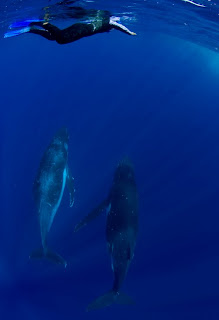I had my first official kite-boarding lesson yesterday where learned how to set up the kite as well as the theory and safety information. Today, Ed was giving a lesson to a man who is in Tonga on a 3-year, around the world sailing trip, so I sat in on the flying portion of the lesson, which was great. I’m excited to try flying the kite myself (hopefully within the next couple of days). The winds have picked up again, so it’s good for kiting, but really bad for whale watching. The last three days, we have gone out whale watching, and have seen quite a bit of topside action (such as breeching and tail slapping, etc). However, with the water being on the rougher side, and the whales not really settling down, we haven’t been in the water very much in the last few days. Today, we were blown out.
We heard a “singer” yesterday. The male humpbacks are the only ones who sing and their song will last for 15-20 minutes. When they sing, they have their nose pointed down and hang vertically in the water before surfacing again. All the whales in Tonga sing the same song which changes slightly during their time here. All of the southern humpback whales sing the same song, although there are slight variations from region to region (similar to how an American accent is different from an Australian accent, although we are both speaking English). The northern humpbacks, however, have a completely different song (so it’s like a completely different language). The humpbacks songs have been recorded as much as 5,000 kilometers away, so it is quite possible that the northern and southern whales can hear each other. What we don’t know (and I don’t know if there is any way to know), if the two groups can understand each other… so in a sense, are the whales bilingual?
Although I grew up learning how to gut a fish, I hadn’t done it in a while, so when Marta told me that there were local Tongan fishermen on the other side of the island, and she wanted to buy some fish, I didn’t need much convincing to join her. The men had their nets out and had caught about 50 or so fish. Marta was able to buy 10 fish for $15 Paang’a (about $7.50 US). As the fishermen threw the fish onto the shore, I thought about how it gave a new meaning to the phrase “catching fish”. She re-taught me how to gut and clean the fish and we had a couple of them for dinner that evening. Absolutely delicious!
 |
| Breeching Humpback |
 |
| Double-finned whale - very unusual. |
 |
| Spinner dolphin |
 |
| Spy-hopping |
 |
| Yours truly |
 |
| Marta and me |
 |
| Milky Way - the stars are unbelievable here. |
 |
| "Catching" and cleaning fish. |














One of the things I love about your pictures Elizabeth is that you capture the whole experience: the people,the place, the animals and the feeling of the area. Keep it up!
ReplyDeleteLiz, these are great photos! I really like the "catching" fish pic compilation. And let me know if you need a whale translator or anything else that I could do to stay on that stunning island.
ReplyDeletethe stars look INSANE Lizzie!! Soooo gorgeous. Your photos are fantastic. In the process of writing you a novel email... oh yes, of course.
ReplyDeleteHi Liz !
ReplyDeleteIs it possible to have a better photograph of this whale with 2 dorsal fins ? I myself published a scientific paper on double-finned cetaceans 20 years ago, and I am thus interested in this photographic evidence !
You can contact me through the page :
http://cryptozoo.pagesperso-orange.fr/communiquer/contact.htm
Michel